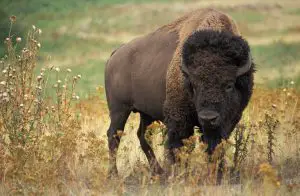The American bison is the national mammal of the United States. These massive animals are strong, surprisingly fast, and excellent swimmers.
Historically, the bison roamed most of North America. The population is much smaller today, but they can still be found in many national parks and other wildlife areas.

What do American bison look like?
American bison are huge animals. They can stand 5 to 6.5 feet tall. They sometimes weigh as much as a ton.
Bison calves weigh 30-70 pounds at birth! When they are young, the calves are orange-red in color. As they grow older, their hair changes to dark brown.

The bison has a thick, shaggy coat. They have sharp, curved horns that can grow up to two feet long. They have a hump over the front shoulders.
Where do American bison live?
The American bison once roamed across most of North America’s grasslands and prairies. Today, their range is limited to just one percent of the area they once occupied.
Now, bison live mostly in national parks and other wildlife areas.

They can be found in Arizona, California, Idaho, Montana, South Dakota, Utah, Alaska, and parts of Canada and Mexico.
However, many of today’s bison are not purebred bison because they have been bred with cattle in the past. The largest population of pure wild bison lives in Yellowstone National Park.
What do American bison eat?
American bison are herbivores, meaning they eat plants. They feed on grass, herbs, shrubs, and twigs.

Bison usually spend 9-11 hours per day foraging and grazing. On average, they eat 1.6 percent of their body mass in vegetation each day.
When it snows, they swing their heads from side to side to clear the snow and find grass to eat.
American bison herd behavior
Cows (females) and bulls (males) usually live in small, separate groups for most of the year. Young calves stay with their mothers. Bison communicate through grunts and bellows.

During mating season, bison join together in very large herds. They may also join in the spring or fall to search for food and water. Bison form a line when they travel together.
Around April-May, cows give birth to one calf. Like humans, female bison have a nine-month pregnancy. They usually go to a secluded area to give birth.
After just a few days, the calf can keep up with the herd. It stays with its mother until the following spring.

American bison population size
American bison are considered a “near threatened” species. Once, an estimated 20 to 30 million bison roamed North America.
But in the 19th century, settlers killed millions of bison for food and sport. These once massive herds were reduced to a few hundred animals.
Today, these numbers have improved. About 500,000 bison live on ranches and wildlife preserves. Fewer than 5,000 wild bison are unfenced.

Although the American bison population is much smaller than it once was, its numbers now remain mostly stable.
Other Interesting Facts About American Bison
The American bison is the largest and heaviest land animal in North America.
The bison’s scientific name is Bison bison.
On average, the American bison lives 12-20 years. Some live even longer.
Despite their huge size, bison can run up to 40 miles per hour. They can also jump fences, swim well, and spin around quickly.

Bison can’t see very well, but they have an excellent sense of smell and hearing.
Before fully digesting their food, bison regurgitate it and chew it again. They graze in the morning, rest, chew regurgitated food (called ruminating), and then graze again.
Bison are known for wallowing, or rolling around in the dust. They do this to get rid of flies and shed hair. This creates large depressions in the land.
These saucer-like “dust bowls” were once a common feature of North American plains.

The bison’s winter coat is so thick and insulated that snow can cover their backs without melting.
Yellowstone National Park is the only place in the United State where bison have lived since prehistoric times.
Bison calves are nicknamed “red dogs” for their orange-red coats.
When a bison’s tail stands straight up, this is a sign that the bison is angry and may be ready to charge. However, bison are unpredictable and can charge at any time.

Theodore Roosevelt founded the American Bison Society and helped save the bison from extinction.
Fossils show that prehistoric bison were even larger than the animals of today. They had horns measuring nine feet long!
More Animal Facts.
